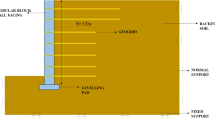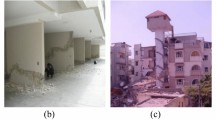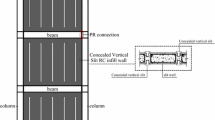Abstract
Whenever a need arises to construct a high retaining wall, the construction of a mechanically stabilized earth (MSE) retaining wall in a multi-tiered configuration is a viable approach than the construction of a single-tiered (rectangular wall). However, the behavior of multi-tiered MSE walls is complex, and unfortunately, the behavior of such walls under seismic loading has not yet been entirely investigated. Therefore, this study performs an exhaustive comparative analysis, on multi-tiered and rectangular MSE walls through a finite element method-based numerical computational tool to look into its performance under seismic loading and their potential failure envelope, i.e., wedge angle. Additionally, this study investigates the influence of the parameters such as the number of tiers, offset distance (D), and horizontal seismic acceleration coefficient (kh) on the walls. The potential failure envelopes of the various wall models are explored, which indicate a combination of overturning and sliding failure accompanied by a distortion of the leveling pad of the walls. However, the sliding behavior reduces as the kh increases and the overturning failure is more prominent. This study proposes a wedge angle correction factor (CΘ) to normalize the deviation of the angle of the potential failure plane under seismic loading, based on the assumption that the standard value of the potential failure plane defined by Federal Highway Administration (FHWA) is valid for all multi-tiered walls since none of the design manuals have suggested clear guidelines that can demonstrate the formation and progression of the wedge angle under seismic loading conditions for multi-tiered walls. The factor of safety (FOS) of the various wall models simulated in the present study satisfies the FHWA guidelines, thus suggesting the construction of tiered walls, at places where huge excavation required for the construction of a rectangular wall is impractical. In the numerical simulations, where the FOS obtained is unsatisfactory as per FHWA guidelines, the current study suggests increasing the length of reinforcement and/or decreasing the vertical spacing between the reinforcing layers to enhance the overall stability of such walls.
















Similar content being viewed by others
Abbreviations
- L :
-
Length of the reinforcement layer (m)
- FOS:
-
Factor of safety
- D :
-
Offset distance between the two consecutive tiers of the tiered wall system (m)
- H 1 :
-
Height of the lowermost wall (m)
- H 2 :
-
Height of the middle wall (m)
- H 3 :
-
Height of the topmost wall (m)
- v :
-
Vertical spacing between the two reinforcing layers (m)
- ϕ :
-
Angle of internal friction of soil (degrees)
- β :
-
Critical wedge angle
- β*:
-
Critical wedge angle suggested by FHWA
- k h :
-
Horizontal seismic acceleration coefficient
- R int :
-
Interface coefficient
- C Θ :
-
Wedge angle correction factor
References
Dasaka SM, Dave TN, Gade VK, Chauhan VB (2014) Seismic earth pressure reduction on gravity retaining walls using EPS geofoam. In: Proceedings of 8th international conference on physical modelling in geotechnical engineering, Perth, Australia, pp 1025–1030
Chauhan VB, Dasaka SM (2018) Performance of a rigid retaining wall with relief shelves. J Perform Constr Facil 32(3):04018021. https://doi.org/10.1061/(ASCE)CF.1943-5509.0001161
Chauhan VB, Khan R, Dasaka SM (2019) Reduction of surcharge induced earth pressure on rigid non-yielding retaining wall using relief shelves. In: I.V. A, Maji V (eds) Geotechnical applications. Lecture notes in civil engineering, vol 13. Springer, Singapore, pp 209–217. https://doi.org/10.1007/978-981-13-0368-5_23
Sankey JE, Soliman A (2004) Tall wall mechanically stabilized earth applications. In: Geotechnical engineering for transportation projects, pp 2149–2158. https://doi.org/10.1061/40744(154)211
Srivastava A, Jaiswal S, Chauhan VB (2021) Numerical study of geosynthetic-reinforced soil wall subjected to static footing loading. Proc Eng Tech Innov 17:13–20. https://doi.org/10.46604/peti.2021.6693
Bathurst RJ (2019) Developments in MSE wall research and design. In: Innovative infrastructure solutions using geosynthetics, GeoMEast 2019, sustainable civil infrastructures, pp 22–50. https://doi.org/10.1007/978-3-030-34242-5_3
Srivastava A, Chauhan VB (2020) Numerical studies on two-tiered MSE walls under seismic loading. S N Appl Sci 2(10):1–7. https://doi.org/10.1007/s42452-020-03414-6
Kongkitkul W, Tatsuoka F, Hirakawa D, Sugimoto T, Kawahata S, Ito M (2010) Time histories of tensile force in geogrid arranged in two full-scale high walls. Geosynth Int 17(1):12–32. https://doi.org/10.1680/gein.2010.17.1.12
Maheshwari P, Chauhan VB (2013) Beams on extensible geosynthetics and stone-column-improved soil. Proc Inst Civ Eng Ground Improv 166(4):233–247. https://doi.org/10.1680/grim.12.00005
Meyer ME, Woods CB, Axhushi N (2013) Reconstruction of a deteriorating, tiered, MSE wall structure in Connecticut. International conference on case histories in geotechnical engineering, vol 40, pp 1–7
Wilson P, Essery D, Taylor TP (2019) St. Jacques Pullman MSE walls lessons learned. In: Transportation association of Canada and ITS Canada 2019 joint conference and exhibition, pp 1–15
Wright GS (2005) Design guidelines for multi-tiered MSE walls. Austin, Texas, Report No. FHWA/TX05/0-4485-2, pp 1–118
Berg RR, Christopher BR, Samtani NC (2009) Design and construction of mechanically stabilized earth walls and reinforced soil slopes, vol I. Federal Highway Administration, Report No. FHWA-NHI-10-024
Leshchinsky D, Han J (2004) Geosynthetic reinforced multitiered walls. J Geotech Geoenviron 130(12):1225–1235. https://doi.org/10.1061/(ASCE)1090-0241(2004)130:12(1225)
Yoo C, Kim SB (2008) Performance of a two-tier geosynthetic reinforced segmental retaining wall under a surcharge load: Full-scale load test and 3D finite element analysis. Geotext Geomembr 26(6):460–472. https://doi.org/10.1016/j.geotexmem.2008.05.008
Liu H, Yang G, Ling HI (2014) Seismic response of multi-tiered reinforced soil retaining walls. Soil Dyn Earthq Eng 61:1–12. https://doi.org/10.1016/j.soildyn.2014.01.012
Bhattacharjee A, Amin MU (2019) Behaviour of two-tiered geosynthetic-reinforced soil walls. INAE Lett 4(2):91–100. https://doi.org/10.1007/s41403-019-00069-7
AASHTO LRFD (2004) Bridge design specifications, 3rd edn. American association of state highway and transportation officials, Washington, D.C.
Collin JG (ed) (1997) Design manual for segmental retaining walls, 2nd edn. National Concrete Masonry Association (NCMA)
Allen TM, Bathurst RJ (2019) Geosynthetic reinforcement stiffness characterization for MSE wall design. Geosynth Int 26(6):592–610. https://doi.org/10.1680/jgein.19.00041
Robert DJ (2017) A modified Mohr–Coulomb model to simulate the behavior of pipelines in unsaturated soils. Comput Geotech 91:146–160. https://doi.org/10.1016/j.compgeo.2017.07.004
Optum G2 (2020) Finite element program for geotechnical analysis. Optum Computational Engineering. www.optumce.com. Accessed 9 Apr 2021
Srivastava A, Jaiswal S, Chauhan VB (2020) The behavior of multi-tiered mechanically stabilized earth (MSE) retaining wall. In: Proceedings of Indian geotechnical conference 2020, Visakhapatnam, India, Paper ID-TH-10-38, 17–19 December 2020, pp 180–191
Jaiswal S, Srivastava A, Chauhan VB (2020) Performance of strip footing on sand bed reinforced with multilayer geotextile with wraparound ends. In: Proceedings of Indian geotechnical conference 2020, Visakhapatnam, India, Paper ID-TH-10–40, 17–19 December 2020, pp 192–202
Ojha R, Chauhan VB (2019) Performance of geosynthetic reinforced segmental retaining walls. In: Shehata H, Brandl H, Bouassida M, Sorour T (eds) Sustainable thoughts in ground improvement and soil stability GeoMEast 2019 sustainable civil infrastructures. Springer, Cham, pp 196–206. https://doi.org/10.1007/978-3-030-34184-8_13
Portelinha FHM, Santos MC, Futai MM (2021) A laboratory device to evaluate geosynthetic load–strain behaviour in MSE walls. Geosynth Int 28(1):32–47. https://doi.org/10.1680/jgein.20.00025
Holtz RD, Lee WF (2002) Internal stability analyses of geosynthetic reinforced retaining walls. Washington State Transportation Commission, No. WA-RD-532.1
Jaiswal S, Chauhan VB (2021) Response of strip footing resting on earth bed reinforced with geotextile with wraparound ends using finite element analysis. Innov Infrastruct Solut 6:121. https://doi.org/10.1007/s41062-021-00486-0
Kannaujiya P, Chauhan VB (2019) Behavior of anchored sheet pile wall. In: Shehata H, Brandl H, Bouassida M, Sorour T (eds) Sustainable thoughts in ground improvement and soil stability GeoMEast 2019 sustainable civil infrastructures. Springer, Cham, pp 184–195. https://doi.org/10.1007/978-3-030-34184-8_12
Pandey A, Chauhan VB (2019) Numerical analysis for the evaluation of pull out capacity of helical anchors in sand. In: Shehata H, Brandl H, Bouassida M Sorour T (eds) Sustainable thoughts in ground improvement and soil stability GeoMEast 2019 sustainable civil infrastructures. Springer, Cham, pp 207–218. https://doi.org/10.1007/978-3-030-34184-8_14
Jaiswal S, Srivastava A, Chauhan VB (2020) Numerical modeling of soil nailed slope using drucker-prager model. In: Proceedings of national conference on geo-science and geo-structures 2020, NIT Jamshedpur, India, Paper ID-GSGS020, 3–4 September 2020
Ojha R, Srivastava A, Chauhan VB (2021) Study of geosynthetic reinforced retaining wall under various loading. In: Sitharam TG et al (eds) Ground improvement techniques: select proceedings of 7th ICRAGEE 2020, vol 118, pp 339–351. https://doi.org/10.1007/978-981-15-9988-0_31
Xue JF, Chen JF (2015) Reinforcement strength reduction in FEM for mechanically stabilized earth structures. J Cent South Univ 22(7):2691–2698. https://doi.org/10.1007/s11771-015-2799-9
Acknowledgements
The first author acknowledges the support received from Mr. Sagar Jaiswal, PG Student, Civil Engineering Department, MMMUT Gorakhpur, UP, India, for the technical support for the finite element simulations using Optum G2.
Author information
Authors and Affiliations
Corresponding author
Ethics declarations
Conflict of interest
The authors declare that they have no conflict of interest.
Rights and permissions
About this article
Cite this article
Srivastava, A., Chauhan, V.B. Parametric studies using finite element modeling for the evaluation of the performance of tiered MSE walls under seismic loading. Innov. Infrastruct. Solut. 6, 159 (2021). https://doi.org/10.1007/s41062-021-00537-6
Received:
Accepted:
Published:
DOI: https://doi.org/10.1007/s41062-021-00537-6




